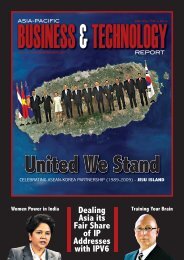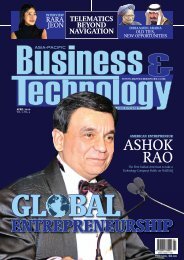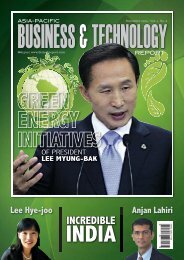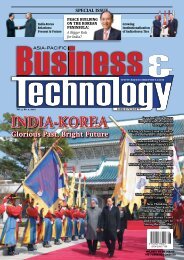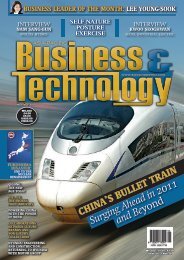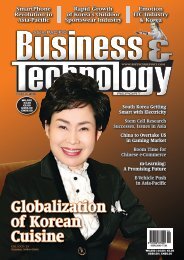GreeN Growth - Asia-Pacific Business and Technology Report
GreeN Growth - Asia-Pacific Business and Technology Report
GreeN Growth - Asia-Pacific Business and Technology Report
- No tags were found...
You also want an ePaper? Increase the reach of your titles
YUMPU automatically turns print PDFs into web optimized ePapers that Google loves.
QaCho Chung Yeonof City Evening DailyBY staff reporterFree newspaper in Korea may have a short history, but according to the recent report 2010Newspaper Advertisement Readership Score published by Korea Press Foundation, free newspaper in Korea has one ofthe highest editorial readership scores <strong>and</strong> advertisement attention rates compared to other papers, including nationaldailies <strong>and</strong> finance newspapers in Korea. Cho Chung Yeon, president of City Evening Daily, was one of the key actorswho established this free newspaper industry in Korea. With his experience working at the Korean Association of Newspapers,he established Metro, Korea’s first free newspaper, <strong>and</strong> worked as the first president of the company. Years laterhe became the executive director at Focus, which is also a free newspaper in Korea. Cho currently operates City EveningDaily, a free evening newspaper company <strong>and</strong> teaches at Jeju National University Law School as an adjunct professor.Here are some excerpts from the interview with Cho.Congratulation on taking overCity Evening Daily as president.How do you feel?Frankly speaking, the position as presidenthasn’t really sunk in yet. At this point,I hope I could manage the company <strong>and</strong>follow the cases of STX <strong>and</strong> Fila. These twocompanies are perfect examples where professionalmanagers took over the companyfrom the owner effectively. As president, asuccessful takeover is my current aspiration.Can you tell us about the briefhistory of City Evening Daily,when it was founded <strong>and</strong> whatmay be the main objective of CityEvening Daily?City Evening Daily is Korea’s first freecomprehensive evening newspaper. Thecorporation was established in January2007 <strong>and</strong> its first issue was published onMay 2, 2007. In Korea, there are a total ofsix free newspapers <strong>and</strong> five of them publishmorning papers. So I thought by targetingthe empty evening newspaper market,our company could offer more news to the10 million commuting Seoul Cityzens fasterthan our competitors.Before you joined City EveningDaily, I heard you also playedan important role in setting upother free newspapers includingMetro <strong>and</strong> Focus. Can youtell me more about thesenewspapers <strong>and</strong> yourexperience?Korea’s free newspaperscan be traced back to Metro.Before Metro, there werefree papers that providedinformation filled withclassified advertisement<strong>and</strong> community news,but there were no freenewspapers that hada format of the currentdaily newspapers.Metro was the first tohave this kind of format.My first job was atthe Korean Associationof Newspapers.While working fouryears at Korea Associationof Newspapers,I witnessed theproblems of the Korean newspaper industry<strong>and</strong> its lack of insight in reading the changesof the readers <strong>and</strong> advertisers. This experiencewas the reason I established Metroin July 2001. After attracting investors, thefirst edition of Metro was published on May31, 2002, <strong>and</strong> on July 16, 2003 I founded Focus.Soon after, City Evening Daily was publishedon May 2, 2007.What are your future plans forCity Evening Daily as president?The global newspaper market is on thestage of decline, except in China <strong>and</strong> India,but mostly in advanced countries. If I onlythought about the intrinsic business domainof City Evening Daily, I would not have takenover the company in a time where newsconsumption <strong>and</strong> production is changing sorapidly due to advanced media technology.But I am not saying I will be exp<strong>and</strong>ing thebusiness sphere thoughtlessly to online <strong>and</strong>mobile media. I just don’t think the profitabilityof mobile <strong>and</strong> online media is testedenough at this point. So, for the time being,I am planning to focus on M&A opportunities<strong>and</strong> added value business City EveningDaily can provide.Free newspaper is a very recentphenomenon in Korea. How doyou see the future of this media?Unlike existing national dailies, the readersof free newspapers are in their 20s <strong>and</strong>30s, <strong>and</strong> these are the main targets the advertisersfavor. Also, many advertisers stillconsider free newspapers the most cost effectivemedia. For these reasons, I believethe free newspaper will continue to strive.However, the rapid advancement of onlinemedia <strong>and</strong> mobile media based on SNS implythat from now on media has to focusmore on the effective execution ofadvertisement, meaning the freenewspaper industry has tomake a lot of effort in order toprovide various products foradvertisers.In Korea, online mediais spreading veryquickly. In this situation,do you thinkoffline media such asyour newspaper hasany future?In Korea, to establish anonline media company islike finding a part-time job inAmerica. It is that easy. Onlinemedia companies that havecredibility are ones that havemassive amount of funds <strong>and</strong>accumulated experience, mostlymedia companies that have longexisted. Without investment,making a online media companyhas no meaning. This is the reasonwhy free newspapers do not havemuch interest in making an onlinenewspaper. But I think this has to changenow. Even though it may not be a newspaperexclusively for online purposes, just asthe offline newspaper had its base on paper,if free newspaper companies want to makeprofit by entering the Internet business,they have to actively utilize the Internet inorder to create various advertisement products.How is City Evening Daily differentfrom other newspapers inKorea? What is your philosophy?The distinction between City EveningDaily <strong>and</strong> other free newspapers is clear. Itis the fast news delivery <strong>and</strong> differentiatedservices. This is also my philosophy.In Korea, usually media companiesare headed by old people.You have achieved this positionat a very young age. What is yoursecret to your success? What motivatedyou to work so hard?Operators of online media companies arevery young, but traditional offline newspapercompanies have many restrictions foryoung people to be on the executive level.When I founded Metro, I was only 29. Nowthinking of it, time really flies. I am notsure achieving the position as president at ayoung age means success, but behind theseContinued from Page 45achievements I always had the habit ofthinking continuously <strong>and</strong> making effortsnot to repeat my failures.Apart from running City EveningDaily, do you have anybusiness plans in the future?I am thinking about operating a consultingbusiness <strong>and</strong> C to C commercesector business. The consulting businessI have in mind is to provide help infunding, legal assistance, tax assistance,management <strong>and</strong> marketing for thosewho have the ideas <strong>and</strong> technology butno funding <strong>and</strong> operational experience.I was in that situation ten years ago.The C to C business was something Iwanted to do since I took over the newspaperfive years ago. Currently, I am planninga type of business that has a formatof a combination of eBay <strong>and</strong> Facebook.The product is expected to be out in themarket around next March.Lastly, do you have a messagefor our young readers whowould like to achieve successlike yourself?When you are facing a difficult problemor obstacles try to overcome it by yourself.It is natural to make mistakes <strong>and</strong> experiencefailures, but it is important to learnToyotaHonda’s biggest competitor in robotics isToyota, the other major Japanese car manufacturer.Car companies’ enthusiasm towardrobotics (General Motor also contributes to aproject with NASA for astronaut robots) canbe explained by the spillovers it generatesfor its main business (e.g. obstacle detectionsensors, orientations). The fact that thecar industry has used industrial robots fordecades to improve their production linesmakes them more conscious that robotshave a positive role in our society.Toyota’s humanoids take a variety of functions,ranging from music players to runningrobots to customer assistants. First upis the amazing trumpeter nicknamed Harry.Equipped with agile fingers <strong>and</strong> talented inmusic interpretation (arm gestures <strong>and</strong> footmovements according to the rhythm), the1.2 meter <strong>and</strong> 35 kg Harry is the perfect entertainerin your living room. If you preferviolin, another Toyota performer can impressyou, <strong>and</strong> although its performance isnot as staggering as Harry’s, we hope it to bemore realistic in the future.As with Honda’s focus on robot mobility,Toyota also concentrated on balance <strong>and</strong>steps. Its bipedal robot is capable of controllingits balance by changing its foot locationswhen pushed (gently!). While running,he can reach a maximum speed of 7km/hwhich is 1km/h faster than ASIMO.Finally, customer service robot Robinatakes care of customers on her own. She isthe tour guide in some of Toyota’s buildings.Her sensors help her avoid people <strong>and</strong> shecan create maps when visiting new locations.During a conversation, her face turnsto the person who is talking to her <strong>and</strong> inaddition to her 20,000 word vocabulary, Robinacan also write. All of this, without beingcontrolled by any external operator, makesthis robot very operational.Toyota’s objective is to transform theseentertainment robots into household appliances<strong>and</strong> deploy them in hospitals. Aswith Honda, spillovers can be mentioned.It includes a mountable chair that can beused in elderly care, allowing people to betransported wherever they want. Toyota alsoenvisions sending its robots to the moon bythe year 2020.SonyThe creators of the world-famous Aibo(a little dog-robot introduced in 1999 thatgained a phenomenal success <strong>and</strong> participatedin every RoboCups until 2008) also developeda humanoid named QRIO. QRIO (forQuest for cuRIOsity) is much smaller thanHonda’s <strong>and</strong> Toyota’s models, st<strong>and</strong>ing at a0.6 meter <strong>and</strong> weighting 7.3 kg. His groupdancing, roller-skating <strong>and</strong> ball throwingabilities are nevertheless remarkable. Unfortunately,Sony decided to cancel the QRIOproject in 2006 at the same time as stoppingproduction of the Aibo.FujitsuContinuing with relatively small humanoidrobots, Fujitsu also developed its own series.The HOAP-3 is 60cm for 8.8kg <strong>and</strong> hasbeen configured by the Learning Algorithms<strong>and</strong> Systems Laboratory of Ecole PolytechniqueFederale de Lausanne to execute funtasks such as playing Pong or drawing portraits.Most HOAPs are now used only in labsthroughout the world because of their highprice.something out of them. Try not to repeat thesame mistakes over <strong>and</strong> over again by goingthrough numerous trials <strong>and</strong> errors. A-PUniversities’ labsRobots developed by universities arenaturally much more research-oriented. TheUniversity of Tokyo’s JSK Robotics Laboratorydesigned Kojiro. The goal was to builda light <strong>and</strong> flexible robot with a similararrangement of skeleton (with a flexiblespine), muscles <strong>and</strong> tendons as human beings.Because the robot’s shape is not easyto control, an ingenious system of learningby small iterative moves has also been developed.Osaka University created two infant robots,Pneuborn-7II <strong>and</strong> Pneuborn-13, withsimilar musculoskeletal structures. The aimis to study these kinds of structures withregard to crawling <strong>and</strong> walking behaviors.Pneumatic muscles made of soft materialare being used to prevent damage or overheatingwhile in friction with the environment.Adult-size robots have also beendeveloped. In cooperation with the OsakaInstitute of <strong>Technology</strong>, Osaka Universitydesigned JoiTech with the aim of playingsoccer. Although its capabilities are verylimited for now, its creators hope that therobot will compete against athletes in thefuture.Waseda University’s Twendy-One is lessexperimental <strong>and</strong> much more adapted tothe need of hospital patients. The caretakercan help the patient to get up out of bed <strong>and</strong>sit on a wheelchair. The robot is also capableof basic household tasks such as helpingwith the breakfast <strong>and</strong> carrying it on a tray.The astonishing dexterity of his h<strong>and</strong> allowshim to put a straw into a glass.Yaskawa Electric CorporationAlso dealing with household care is thetransformation of the Motoman industrialrobot into a home cooker. The robot cantake verbal orders <strong>and</strong> cook a variety ofJapanese meals. Other industrial robots ofthe company have been developed to helpelderly during shopping.Japan is definitely the country that isbest prepared to see humanoids walkingin its streets. The vast number of organizations(many more than the ones cited hereabove) <strong>and</strong> the know-how they already acquiredplace the country as number one inthe robotics field in <strong>Asia</strong> <strong>and</strong> in the world.The leaders at the tops of these organizationsclearly underst<strong>and</strong> the importance ofrobots in our future societies <strong>and</strong> deploy theresources needed to innovate. Finally, thegood relations between companies <strong>and</strong> universitiesallow innovation to be integratedvery quickly from the experimental stageinto the final humanoid model. A-P48 | A-P BUSINESS & TECHNOLOGY REPORT A-P BUSINESS & TECHNOLOGY REPORT | 49



